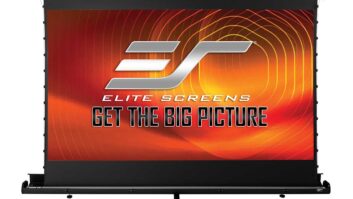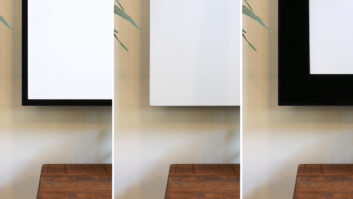You have just secured the contract for your next home theater project, and now it is time to put a gear list together. The trouble is that your client wants a really big screen, and he wont settle for the 50-inch plasma that you usually
install as the centerpiece of your system. Welcome to the exciting, yet sometimes confusing, world of video projector selection.
Even for an experienced residential electronic systems contractor, selecting the right video projector for a home entertainment room is not a straightforward process. There are many room parameters and projector features to consider, if you intend to deliver the most value to your client. Fortunately, however, most experts agree on what should and, more importantly, should not be priorities in your criteria.
Know Your Room
Before getting to the projector itself, you will need to learn more about the room in which it will reside. To do this, its important to see the room in person, said Planars head of global sales, Jim Davis. There are a lot of parts that need to be analyzed before you make a good proposal to a customer, and I dont think thats possible to do over the phone, he said. Even if you ask all of the right questions, youll see things that you never considered.
Digital Projection’s dVision 1080p ProjectorSpecifically, does the client have a dedicated home theater space in mind or does he prefer a mixed-use media room/family room where ambient light will be a factor? The difference is a big one, as ambient light can be a tough match for certain types of projectors and screens.
Any home theater projector is going to be bright enough in a darkened space, so for the most part we take brightness of the projector out of the criteria for a dedicated home theater space, said InFocus senior product manager, Robb Robles. But it does come into play when its a three-wall family room, multi-purpose space.
Knowing the style of room will help you choose a brighter projector for a high ambient light environment or a projector with better contrast ratio, dynamic range, and color accuracy for a darkened room.
Next in your selection process, also take note of the size and shape of the room. Experts agree that everything flows from and is determined by these dimensions. That really is the most critical determining factor, Robles noted. Everything about that spacethe screen size, the resolutionthese are all things that are pretty directly related to what the room will allow, as well as what the client wants to get out of the experience. Some people have notions of a 106-inch screen, but their room is 110 inches wide, and thats not going to work very well.
Where Do They Like to Sit?
Pat Bradley an Imaging Science Foundation instructor, who also serves as 50 percent of Runcos training faculty, said that after finding out how big the media or home theater room is, you should interview your client about his specific viewing preferences. Specifically, where does he typically sit in a traditional movie house? Knowing this, Bradley explained, will provide clues about the quality of your clients eyesight and his tolerance for video artifacts (visible pixels).
I simply ask a client where they like to sit when theyre the first one to enter a movie theater for a matine, Bradley said. If he likes to sit in the front of the house, then hes at about a one-to-one relationship between screen width and his seating position, but most people dont sit at the front of the house. They sit halfway back, two-thirds of the way back, or all the way back.
InFocus’ PlayBig IN78 single-chip DLPNext, take that information and adjust it, proportionally, for a smaller venue. If the guy tells me that he sits one and half screen widths away, then Ill probably model his home theater in a similar fashion, Bradley said.
Seating distance and room dimensions will help you determine a screen size, which will ultimately help you select a proper projector for your client. If a client has in mind a 10-foot-wide screen, and he has a wide enough room to accommodate it and a deep enough room for his preferred seating distance (typically 1.5 to three times the screen width), then he will need a projector that can drive that screen. Thats classic lumens over area, times screen gain formula, Bradley said. SMPTE minimums for a professional house are 12-14 foot-Lamberts, minimum, and we find that in a dedicated room, minimums make everybody happy.
In a multi-purpose room with high ambient light, you will not only need a brighter projector, but may also need to use a gray screen that adds gain to the black levels of video. The challenge, at this point, is improving the performance of the projector, without blowing your clients budget.
Content Questions
Not to be overlooked is what type of content the client will be viewing most often on his projector. You may find out that your customer uses his projector to watch HDTV 50 percent of the time, and thats going to drive you to a solution that might be different than if they answered, I just watch movies, said Planars Davis.
Then you must determine what sources your client might use. If theyre a movie watcher, you could find out if theyre going to want a Blu-ray or HD DVD player. If theyre a television watcher who also likes to watch DVDs once in a while, then that takes a lot of the pressure off of the resolution question, because HD programming is not shown in 1080p, and a 720p projector would be more than enough for the native resolution of a 1080i or 720p HD broadcast or 480 DVD movie.
Projector Capabilities
Digital Projection Inc.s home cinema market manager, George Walter, said that once you understand your clients room characteristics and expectations for his system, its time to find a projector that not only meets the performance requirements, but fits into the room without being a visual distraction or an aesthetic distraction.
Robles believes that it is important to choose a projector that has proper contrast ratio, dynamic range in gray levels, and color saturation and accuracy. Only after that criteria is met should resolution factor in. In fact, most experts agree that resolution is one of the least important video projector specifications. The only exception is if youre seated very close to the screen and can start to notice the pixel structure of say 720p, Robles pointed out. In a typical home theater in this industry the first row is far enough back, making color and contrast the most important.
Planar’s PD7150 features DLP dual-chip technologyPlanars Davis agreed that installers should be focusing on what a customer really wants to watch and not over-sell them on 1080p just because its future proof, he said. If it makes sense, then great, but I would ask them a few questions and find out what theyre watching and make them understand that 720p is a very good resolution.
Digital Projections Walter said that the biggest advantage of a 1080p projector is that its smaller pixels allow the viewer to be closer to the screen at the front row of seats, resulting in a smoother overall image. On the other hand, he added, A 720p 3-chip would give noticeably better colors than a 1080p single-chip and may provide a more appealing picture. And less video processing is required to upscale to 720p than to 1080p when viewing standard-definition DVDs, he said.
On the other hand inherent contrast ratio of the projector is a very important characteristic, according to Gary Plavin, North American president of projectiondesign. This means, what is the contrast ratio of the projector without active irising systems that distort projector contrast ratios? he said. Active irising increases contrast ratio but doesnt improve the image quality. If a display/light engine combination produces a 4000:1 contrast ratio, then active irising wont improve this, although the number will be higher due to how contrast is measured. Active irising does enhance shadow detail in lower light images, however.
The final detail, Plavin said, is knowing your manufacturers optical calculators so that you can position the projector properly for the image size planned from the installation location. This generally means knowing the projectors throw ratio, and, if it does not have lens shifting capabilities, the offset percentage of the lens.
Jeremy J. Glowacki is editor of Residential Systems in New York City.







